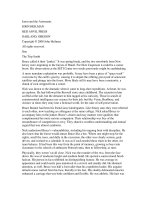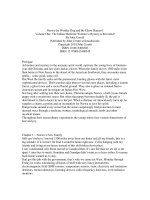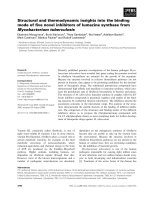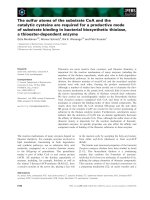Wallace stevens and the apocalyptic mode
Bạn đang xem bản rút gọn của tài liệu. Xem và tải ngay bản đầy đủ của tài liệu tại đây (1.29 MB, 277 trang )
00front.qxd
5/10/05
7:09 PM
Page i
Wallace Stevens
and the Apocalyptic Mode
00front.qxd
5/10/05
7:09 PM
Page ii
00front.qxd
5/10/05
7:09 PM
Page iii
Wallace Stevens
and the Apocalyptic Mode
University of Iowa Press
00front.qxd
5/10/05
7:09 PM
Page iv
University of Iowa Press, Iowa City
Copyright © by the University of Iowa Press
All rights reserved
Printed in the United States of America
/>No part of this book may be reproduced or
used in any form or by any means without
permission in writing from the publisher. All
reasonable steps have been taken to contact
copyright holders of material used in this book.
The publisher would be pleased to make suitable
arrangements with any whom it has not been
possible to reach.
The University of Iowa Press is a member of
Green Press Initiative and is committed to
preserving natural resources.
Printed on acid-free paper
Library of Congress Cataloging-in-Publication Data
Woodland, Malcolm, –.
Wallace Stevens and the apocalyptic mode / by Malcolm Woodland.
p.
cm.
Includes bibliographical references and index.
--- (cloth)
. Stevens, Wallace, –—Criticism and interpretation. . Literature and
history—United States—History—th century. . Stevens, Wallace, –—
Knowledge—History. . Apocalyptic literature—History and criticism. . End
of the world in literature. . War in literature. I. Title.
.
'.—dc
C
00front.qxd
5/10/05
7:09 PM
Page v
For my mother, and in memory of my father
00front.qxd
5/10/05
7:09 PM
Page vi
00front.qxd
5/10/05
7:09 PM
Page vii
Contents
Acknowledgments ix
Introduction xi
Abbreviations xix
. Past Apocalypse: Stevens, History, Theory
. An Ever-Enlarging Incoherence: War, Modernisms,
and Masculinities
. What Could Not Be Shaken: Meditation in a
Time of War
. The Refuge That the End Creates: Pastoral and
Apocalyptic Modes in “Credences of Summer”
. Mournful Making: Apocalypse and Elegy in
“The Auroras of Autumn”
. Past Apocalypse, Past Stevens: Jorie Graham’s
The Errancy
Afterword: Ending with Strand and Ashbery
Notes
Bibliography
Index
00front.qxd
5/10/05
7:09 PM
Page viii
00front.qxd
5/10/05
7:09 PM
Page ix
Acknowledgments
Thanks are due to Eleanor Cook, whose support and encouragement from the early stages of this project have been invaluable. I owe
a similar debt of gratitude to John Reibetanz and Linda Munk.
I would also like to thank Professors Linda Hutcheon and Marlene
Goldman, both of the University of Toronto, who both have read
portions of the manuscript. Research assistants Rob Mancini and
Zachariah Pickard have helped immensely in casting their cold eyes
on a manuscript that has at times been much in need of proofreading. Financial assistance from the University of Toronto and the
Social Sciences and Humanities Research Council of Canada has
facilitated much of the work on this project. Finally, I would like to
thank Prasenjit Gupta, Holly Carver, John Mulvihill, and all others
involved at the University of Iowa Press for their support of and work
on this project.
Excerpts from The Collected Poems of Wallace Stevens by Wallace
Stevens. Copyright © by Wallace Stevens and renewed by
Holly Stevens. Reprinted by permission of Alfred A. Knopf, a division of Random House, Inc., and Faber and Faber Ltd.
Excerpts from Letters of Wallace Stevens by Wallace Stevens. Copyright © by Holly Stevens. Reprinted by permission of Alfred A.
Knopf, a division of Random House, Inc., and Faber and Faber Ltd.
Excerpts from Selected Poems by Mark Strand. Copyright © ,
by Mark Strand. Reprinted by permission of Alfred A. Knopf,
a division of Random House, Inc.
Excerpts from A Wave by John Ashbery. Copyright © , ,
, by John Ashbery. Reprinted by permission of Georges
Borchardt, Inc., for the author, by the Noonday Press, a division of
Farrar, Straus, & Giroux, and Carcanet Press Ltd.
Excerpts from The End of Beauty by Jorie Graham. Copyright ©
by Jorie Graham. Reprinted by permission of the Ecco Press.
00front.qxd
5/10/05
7:09 PM
Page x
Excerpts from Opus Posthumous by Wallace Stevens, edited by Samuel
French Morse. Copyright © by Elsie Stevens and Holly Stevens.
Reprinted by permission of Alfred A. Knopf, a division of Random
House, Inc., and Faber and Faber Ltd.
Excerpts from Materialism by Jorie Graham. Copyright © by
Jorie Graham. Reprinted by permission of the Ecco Press.
Excerpts from The Errancy by Jorie Graham. Copyright © by
Jorie Graham. Reprinted by permission of the Ecco Press and Carcanet Press Ltd. ().
Excerpts from The Necessary Angel by Wallace Stevens. Copyright ©
by Wallace Stevens. Used by permission of Alfred A. Knopf, a
division of Random House, Inc., and Faber and Faber Ltd.
x
Acknowledgments
00front.qxd
5/10/05
7:09 PM
Page xi
Introduction
Why has it been possible to read Stevens as both an apocalyptic
and an antiapocalyptic poet? Why has it been possible to read Stevens
as both a (belated) romantic/modernist and as a poststructuralist/
postmodernist? These two questions, I hope to show, are intimately
related. To take a stance toward apocalyptic discourse is to take a
stance toward the ends and beginnings of historical eras and, by
implication, toward the ends and beginnings of cultural and aesthetic
eras. For Stevens, confronting the immense sociopolitical upheaval
and human suffering of the late s and early s also meant
confronting the possible dissolution of the aesthetic principles that
guided his creative projects. Stevens’s attitude toward the former offers
a glimpse of his attitude toward the latter, toward the possibility
that the dominant aesthetic modes of the first part of the twentieth
century had been shaken to their foundations, were on the verge of
collapse or invalidation, and were likely to be replaced by something
that as yet had no name or discernible form.
To make such claims is not to suggest that the “dividing line” (if
there is such a thing) between modernism and postmodernism
should be shifted back twenty or so years from its usual position in
the mid to late s; it is, however, to suggest that the practitioners
and proponents of an already changing and varied modernist aesthetic—born to a large extent out of a sense of cultural crisis and
exhaustion in the early part of the century—were now facing a second crisis that seemed to threaten that same aesthetic. It is to suggest, furthermore, that in most cases these artists were developing
strategies of resistance against that threat and were struggling to
maintain the aesthetic values in which they had so heavily invested.
Stevens’s engagement with apocalypse can be understood in relation
to this cultural/historical context. His oeuvre, in other words, is in
many ways characteristic of late modernism. Tyrus Miller’s description of the tensions that mark the cultural artifacts of that period
provides some clarification of how my reading of Stevens will proceed: “At first glance, late modernist writing appears a distinctly selfconscious manifestation of the aging and decline of modernism, in
00front.qxd
5/10/05
7:09 PM
Page xii
both its institutional and ideological dimensions. More surprising,
however, such writing also strongly anticipates future developments,
so that without forcing, it might easily fit into a narrative of emergent postmodernism” (). My only disagreement with Miller is over
the verb “anticipates,” which does not do justice to the subtlety of
his study and, in fact, offers a historically displaced version of that
early modernist privileging of the “new” that his work seems intended
to question. (See, for example, his discussion of the modernist rhetoric of beginnings, on p. of his introduction.) If, as Linda Hutcheon
insists (Poetics , , ), postmodernism is both continuous and
discontinuous with modernism, it would make more sense to say
that postmodernism echoes certain aspects of late modernism, and
that writers who appear to “anticipate” postmodernism are the beneficiaries of that discourse’s paradoxically retrospective tendency. In
placing Stevens within this context, then, I do not wish to grant
him any special anticipatory insight; from my point of view, it would
be far more surprising to discover that a much-read, late modernist writer did not appear to anticipate some aspects of an emergent
postmodernism.
This is not the first critical work to consider the place of apocalypse in Stevens’s poetry. A brief summary of the major critics who
have dealt with the issue should suffice to reveal the basic positions
already taken and the nature of the particular contradiction I wish
to explore—the contradiction, that is, between readings that locate
an apocalyptic strain in Stevens’s poetry and those that find an antiapocalyptic one. Harold Bloom makes occasional comments on apocalypse throughout Wallace Stevens: The Poems of Our Climate (),
the most intriguing, perhaps, being the observation, in relation to
“Saint John and the Back-Ache,” that “St. John is . . . the apocalyptic
impulse that [Stevens] has dismissed for so long but that will begin
to break in upon his reveries in An Ordinary Evening in New Haven
and The Rock and then will dominate the poems composed from
through ” (). In contrast, Eleanor Cook, in Poetry, Word-Play,
and Word-War in Wallace Stevens (), gives a very detailed reading of “An Ordinary Evening in New Haven” as “a purgatorial poem
in the antiapocalyptic mode” (). And Charles Berger’s Forms of
Farewell () actually reverses Bloom’s narrative of an increasingly
apocalyptic oeuvre: “One can argue that Stevens’ late poetry begins
in an atmosphere of premature closure, as Stevens fears that the war
xii
Introduction
00front.qxd
5/10/05
7:09 PM
Page xiii
will bring on a sudden end to civilized life. When these fears subside,
we get poems that I have called counterapocalyptic, such as ‘Credences of Summer’ and ‘An Ordinary Evening in New Haven,’ poems
which begin to see the world as saved ” (xi). Part of the difference
between Bloom and Berger may lie in their respective understandings
of “apocalypse.” Berger writes of it primarily in terms of events—
World War II above all—so catastrophic that they seem to pose an
eschatological threat; for Bloom, the primary significance of the term
lies in its etymological metaphor of unveiling and in an apocalypse’s
status as a record of visionary experience. Yet the latter is precisely
the understanding of apocalypse that leads to Cook’s “antiapocalyptic” reading of “An Ordinary Evening.” And Berger’s understanding
of apocalypse has much in common with the one that underwrites
James Longenbach’s extended treatment of Stevens’s antiapocalyptic stance during World War II in Wallace Stevens: The Plain Sense of
Things (). A recent issue of the Wallace Stevens Journal devoted
to apocalyptic language in Stevens (, no. , fall ) demonstrates
a similar range of approaches. It may begin to look as though I am
gathering together the sheep and goats for some final eschatological
judgment and separation, but my purpose is rather to ask whether
both groups might be at least partially “justified” in their accounts
of Stevens’s (anti)apocalypticism, and whether something irreducibly
ambivalent, double, or undecidable in his texts must produce these
readings.
In turning to the question of Stevens’s place in literary history,
I am less willing to leave the poet in an indeterminate space, this time
a space between the modern and the postmodern. While remaining
attentive, I hope, to the typically Stevensian valuation of process,
openness, irony, multiplicity, uncertainty, possibility, and so on,
especially as these emerge in his distinctive verbal playfulness and
complex poetic texture, I find it impossible to ignore the marks in
his oeuvre of a desire for the possibility of stability, and above all
for the possibility of a certain kind of poetic power descended from
a tradition of “truth,” a tradition that is embodied nowhere more
forcefully than in prophetic and apocalyptic language. Such a desire
cannot easily be subsumed within a reading that insists that Stevens
is postmodern. In making this claim, however, I hope to refrain from
the value judgments often involved in discussions of Stevens’s place
in literary history—judgments made by both those who praise and
Introduction
xiii
00front.qxd
5/10/05
7:09 PM
Page xiv
those who damn his work. Angus Cleghorn, for example, enthusiastically reads Stevens as a poet who “practices what is now known
as the postmodern enterprise of parodying . . . established ideologies,
forms, and tropes” (Stevens’ Poetics ), and is disappointed that “Life
on a Battleship” “ends by repeating the synecdochic power of one part
for the whole” (). David R. Jarraway, taking a similar approach,
finds in “Credences of Summer” the marks of “an argument not carried far enough” () for a full deconstruction of the pastoral locus
amoenus. It seems insufficient to note these contradictions and then
set them aside in the name of Stevens’s postmodern status. By registering these tensions as momentary failures or marks of incompleteness,
critics situate them and Stevens’s work as a whole within a teleology
whose end—in more senses than one—is postmodernism, and that
teleology in turn underwrites a series of judgments as to what is and
is not valuable in Stevens’s poetry. Such judgments play a similar role
in the largely negative assessment of Stevens’s work by Lee M. Jenkins, whose “‘counter-mutter,’ in relation to Stevens and some Stevensians” (), argues against readings like Cleghorn’s and Jarraway’s in
order to construct a critique of the poet’s aesthetics and ideology.
Oddly enough, these two opposing approaches share a common
assumption: the worth of Stevens’s oeuvre depends on its adherence
to “our” postmodern values. Such readings tend, in spite of themselves, to reduce or ignore some of the most intense sites of tension—
especially of unintentional tension—in Stevens’s oeuvre, almost to
the same extent as readings that privilege the romantic or visionary
aspects of his work (those of Bloom, Carroll, McCann, and so on).
My work has its own biases, since it privileges unconscious contradiction over both visionary certainty and postmodern skepticism in
reading Stevens. I can only identify that assumption as both starting
point and terminus of my study and hope that my own “heavy historical sail” (CP ) will at least end with a renewed sense of the
complexity of Stevens’s texts.
To claim or even merely assume that a work belongs to one period
rather than another is itself a doubled gesture: it facilitates the production of a certain range of interpretations, but also excludes another
range, and may have little more than a heuristic value. Periodization
takes for granted an ability to search through an impossibly large and
heterogeneous array of cultural phenomena and, without the interference of any bias, find some underlying “same” that will “define”
xiv
Introduction
00front.qxd
5/10/05
7:09 PM
Page xv
an era’s conceptual and temporal limits. Obviously, such a search will
assume a concept, a set of boundaries, and a whole range of biases in
the mere selection of its first object. And even if this initial epistemological difficulty is set aside, the very process of reducing differences to an underlying sameness would remain thoroughly inimical
to the bottomless skepticism of postmodernism—so much so, perhaps, that postmodernism should not, by its own logic, “exist” or
have a “name” (unless by its own paradoxical logic this is precisely
the fate it should have come to). One could argue that postmodernism has been spared this fate by the sheer conflicting variety of critical attempts to define or describe “postmodernism.” And, of course,
there are critics such as Bloom who insist that postmodernism does
not exist and never has existed. But even if postmodernism is nothing more than a fiction, even if it is, like all our period concepts, an
ideological construct that has been imposed on a diverse body of
cultural artifacts that otherwise have no commonality, it seems presumptuous to think it possible to step outside of or annul this history. It was my intention in this study to work with this history and
to investigate how it works in our attempts to read Stevens.
My final chapter offers another perspective on Stevens’s place in
literary history. It examines the work of a contemporary poet, Jorie
Graham, who not only reads Stevens but whose poetry quotes from
Stevens’s oeuvre and shows other marks of his influence. Graham’s
work is of particular relevance in this context because it consistently
and quite self-consciously adopts an antiapocalyptic stance and echoes
Stevens’s own engagement with apocalypse from Graham’s later position in the history of that discourse. I will focus on Graham’s
collection, The Errancy, and will show that her antiapocalyptic and
antieschatological poetry involves a very different attitude toward
the possibility of a radical break with a particular cultural or aesthetic
dispensation. In addition to the recontextualization of Stevens, then,
this chapter also offers a more thorough exploration of my first two
chapters’ claims about the differences between modernist and postmodernist stances toward the discourse of the End.
The contradictions that interest me demand the closest possible
attention to Stevens’s texts, and for this reason my discussion is limited to four points of crisis in Stevens’s career—two that emerged
just before and during World War II, and two that emerged afterward. My first chapter establishes the theoretical framework for the
Introduction
xv
00front.qxd
5/10/05
7:09 PM
Page xvi
discussion and has four sections. The first and briefest explores
Stevens’s use of the words “apocalypse” and “apocalyptic” in order to
suggest his complex and ambivalent stance toward the terms and all
that they signify in his poetry. The second section elucidates the precise literary status of the apocalyptic elements in Stevens’s poetry,
working largely with Alastair Fowler’s deeply historicized understanding of genre and mode. And since to write about a genre or a
mode is to write about a textual history, this section is followed by a
brief history of the end of time, with emphasis on apocalypse as the
inscription of a particular discursive power and a particular desire—
a power and a desire that are central to Stevens’s engagement with
apocalypse. Finally, the first chapter discusses the meaning of “antiapocalypse” and “antiapocalyptic,” and, through a consideration of
the writings of Jacques Derrida, Frank Kermode, Paul Ricoeur, and
others, asks whether an antiapocalyptic discourse might always retain
what Derrida calls an “apocalyptic desire” (“Apocalyptic” ). This
last possibility proves crucial to the capacity of Stevens’s poetry to
generate apocalyptic and antiapocalyptic readings.
My second chapter examines Stevens’s two wartime essays “The
Noble Rider and the Sound of Words” () and “The Figure of
the Youth as Virile Poet” (), as well as the poems “Extracts from
Addresses to the Academy of Fine Ideas” () and “Repetitions of
a Young Captain” (), with primary emphasis on the first of these
texts. The chapter is concerned with the apocalyptic rhetoric that
emerges in “The Noble Rider” and in some crucial postmodernist
and poststructuralist texts, and asks whether Stevens’s stance toward
the apparent collapse of modernism is homologous with the stance
taken later in the century, especially in the works of Jean-François
Lyotard, Derrida, Michel Foucault, and others. My belief is that it is
not, and a close reading of the essays’ often contradictory figurations
of masculinity helps locate the precise points at which Stevens resists
the possibility of cultural collapse. My third chapter further develops
these concerns in relation to a number of relatively neglected wartime
poems. I should make it clear, too, that in beginning with works from
the period of World War II, I am not claiming that prophetic and
apocalyptic elements emerged only at this point in Stevens’s career.
One need only think of “Sunday Morning,” with its proclamation
that “The sky will be much friendlier then than now” (CP ) and its
absurdist vision of heavenly perfection, to recognize how untenable
xvi
Introduction
00front.qxd
5/10/05
7:09 PM
Page xvii
such a claim would be. These earlier engagements with apocalyptic
discourse have more in common with the optimistic, early modernist
use of apocalypse as a way of troping modernism’s desire to break
with the past; it is the kind of apocalypse one finds, for example, in
the opening prose sections of Williams’s Spring and All. It is only
during the war years that this rhetoric takes on a new dimension in
Stevens’s work. This later version of apocalypse threatens to end the
era that the earlier version helped inaugurate, and Stevens’s resistance
to this end tells us a great deal about his aesthetics and his place in
literary history.
The second half of the book considers two of Stevens’s major
postwar poems, “Credences of Summer” () and “The Auroras of
Autumn” (), devoting one chapter to each and giving particular
attention to how the interaction of (anti)apocalyptic modes with,
respectively, pastoral and elegy, involves a historically specific reconfiguration of previous relationships between apocalypse, pastoral, and
elegy. My reading of “Credences” suggests that the poem’s contradictory configurations of pastoral and visionary, apocalyptic topoi reveal
an irreducibly doubled stance toward the apocalyptic mode, a mode
that the poem simultaneously resists and desires. In “Auroras,” Stevens
reconfigures conventional relationships among elegy, self-elegy, and
apocalypse; here, his investment in a nostalgic fiction of gender marks
his final site of resistance to the cultural and aesthetic implications
of the poem’s strangely postapocalyptic apocalyptic mode.
In locating these points of resistance or contradiction in Stevens’s
poetry, I am attempting neither to lower nor to raise the value and
stature of his work; for me, the question of whether Stevens is modern or postmodern has nothing to do with the quality of his poetry
in either aesthetic or moral terms. Obviously, the mere decision to
write about Stevens involves many value judgments, and my own
desire to avoid making such judgments and particularly to avoid
evaluating Stevens according to his status as modern or postmodern
has its own ideological assumptions. But I would still like to proceed
as though the terms “modernist” and “postmodernist” had a primarily descriptive and explanatory power or function. When used in this
way, they help to expose and clarify some still unarticulated tensions
in Stevens’s poetry.
Introduction
xvii
00front.qxd
5/10/05
7:09 PM
Page xviii
00front.qxd
5/10/05
7:09 PM
Page xix
Abbreviations
AW
John Ashbery. A Wave. New York: Noonday Press/
Farrar, Straus and Giroux, .
CP
Wallace Stevens. The Collected Poems of Wallace Stevens.
. New York: Vintage Books, .
EB
Jorie Graham. The End of Beauty. Hopewell, N.J.: Ecco
Press, .
LWS
Wallace Stevens. Letters of Wallace Stevens. Edited by
Holly Stevens. New York: Knopf, .
M
Jorie Graham. Materialism. Hopewell, N.J.: Ecco Press,
.
NA
Wallace Stevens. The Necessary Angel: Essays on Reality
and the Imagination. New York: Vintage Books, .
OP
Wallace Stevens. Opus Posthumous. Revised, enlarged,
and corrected Edition. Edited by Milton J. Bates. New
York: Vintage Books, .
SP
Mark Strand. Selected Poems. . New York: Knopf,
.
TE
Jorie Graham. The Errancy. Hopewell, N.J.: Ecco Press,
.
00front.qxd
5/10/05
7:09 PM
Page xx
01chap1.qxd
5/10/05
7:10 PM
Page 1
Part I: Stevens and the End of War
01chap1.qxd
5/10/05
7:10 PM
Page 2
01chap1.qxd
5/10/05
7:10 PM
Page 3
chapter one
Past Apocalypse
Stevens, History, Theory
It seems reasonable enough, given my subject, to begin with the End,
or at least with Wallace Stevens’s attitudes toward the End. Quoted
below are three passages that provide some sense of the specific
lexical meanings Stevens attached to the words “apocalypse” and
“apocalyptic.” In each instance, these meanings are anything but
fixed and final; Stevens seems to rethink the term and its implications each time he comes to it. The passages quoted below thus register a complex stance or a shifting succession of stances toward these
words and their meanings. These stances will be the subject of most
of this study. Each of the passages deals in a different way with the
immensely troubled political and economic scene of the late s
and early s—the depression, the spread of fascism and of communism, World War II; the passages come, respectively, from canto
iii of “A Duck for Dinner” (the fourth poem in Owl’s Clover, ),
canto vii of “Extracts from Addresses to the Academy of Fine Ideas”
(), and canto iv of “Description without Place” ():
“Is each man thinking his separate thoughts or, for once,
Are all men thinking together as one, thinking
Each other’s thoughts, thinking a single thought,
Disclosed in everything, transcended, poised
For the syllable, poised for the touch? But that
Apocalypse was not contrived for parks,
Geranium budgets, pay-roll water-falls,
The clank of the carrousel and, under the trees,
The sheep-like falling-in of distances,
Converging on the statue, white and high.” (OP )
To have satisfied the mind and turn to see,
(That being as much belief as we may have,)
And turn to look and say there is no more
01chap1.qxd
5/10/05
7:10 PM
Page 4
Than this, in this alone I may believe,
Whatever it may be; then one’s belief
Resists each past apocalypse, rejects
Ceylon, wants nothing from the sea, la belle
Aux crinolines, smears out mad mountains. (CP )
The eye of Lenin kept the far-off shapes.
His mind raised up, down-drowned, the chariots.
And reaches, beaches, tomorrow’s regions became
One thinking of apocalyptic legions. (CP )
The third passage could initially be written off as an intellectual commonplace, since it recognizes a straightforward homology between
the teleologisms of marxism and of Judaic and Christian apocalypse.
Such a reading would be concordant with some of Stevens’s other
comments on communism—for instance, the statement that communism promises “a practicable earthly paradise” (NA ), or the failed
socialist apocalypse of the passage from “A Duck for Dinner,” both
of which suggest that he understood communism to offer a secularized version of the millennium mentioned in Rev. :. More importantly, Stevens’s use of “apocalyptic” in “Description without Place”
attests in several different ways to the power of apocalypse. There
is, no doubt, a certain irony in the suggestion that Lenin, in contemplating the planned communist state that would also supplant
the Christian faith in Russia, is nevertheless engaging in the “apocalyptic” thinking so central to that faith; here, apocalypse gets the last
word. But Stevens’s purpose may involve more than an ironic critique
of Lenin’s failings: the passage also underscores the sheer longevity
and inescapability of apocalypse as a way of thinking about history.
The form and force of the apocalyptic narrative is capable of surviving its specific theological contents; those who have most rigorously
dismissed such contents may already be burdened with the most
intense apocalyptic desires. Above all, Stevens points to a relationship between apocalypse and power: apocalyptic discourse facilitates
the creation of powerful narratives of history, and offers a certain discursive mastery over history’s complexities. In “Description,” it is a
discourse mastered by one who desires the highest degree of political power, and it thus has a role in the actualization of that desire.
Stevens and the End of War









